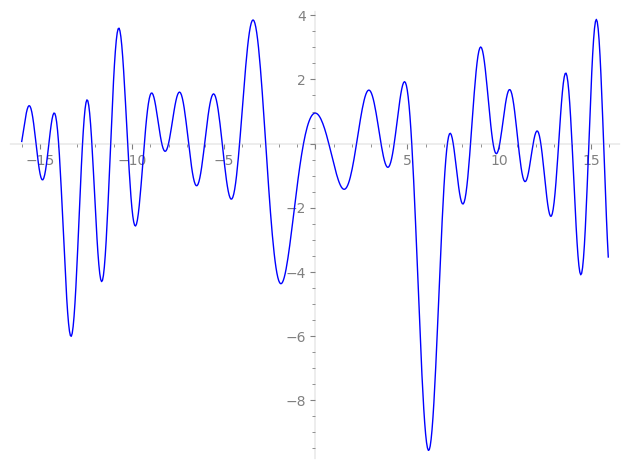| L(s) = 1 | + (−0.671 + 1.88i)2-s + (−3.09 − 2.53i)4-s − 4.54·5-s + 5.76i·7-s + (6.84 − 4.13i)8-s + (3.05 − 8.56i)10-s − 10.1i·11-s − 13.5·13-s + (−10.8 − 3.87i)14-s + (3.19 + 15.6i)16-s + 7.96·17-s + 4.35i·19-s + (14.0 + 11.5i)20-s + (19.1 + 6.81i)22-s − 38.6i·23-s + ⋯ |
| L(s) = 1 | + (−0.335 + 0.941i)2-s + (−0.774 − 0.632i)4-s − 0.909·5-s + 0.823i·7-s + (0.855 − 0.517i)8-s + (0.305 − 0.856i)10-s − 0.921i·11-s − 1.04·13-s + (−0.775 − 0.276i)14-s + (0.199 + 0.979i)16-s + 0.468·17-s + 0.229i·19-s + (0.704 + 0.575i)20-s + (0.868 + 0.309i)22-s − 1.68i·23-s + ⋯ |
\[\begin{aligned}\Lambda(s)=\mathstrut & 684 ^{s/2} \, \Gamma_{\C}(s) \, L(s)\cr =\mathstrut & (0.632 - 0.774i)\, \overline{\Lambda}(3-s) \end{aligned}\]
\[\begin{aligned}\Lambda(s)=\mathstrut & 684 ^{s/2} \, \Gamma_{\C}(s+1) \, L(s)\cr =\mathstrut & (0.632 - 0.774i)\, \overline{\Lambda}(1-s) \end{aligned}\]
Particular Values
| \(L(\frac{3}{2})\) |
\(\approx\) |
\(0.9507268747\) |
| \(L(\frac12)\) |
\(\approx\) |
\(0.9507268747\) |
| \(L(2)\) |
|
not available |
| \(L(1)\) |
|
not available |
\(L(s) = \displaystyle \prod_{p} F_p(p^{-s})^{-1} \)
| $p$ | $F_p(T)$ |
|---|
| bad | 2 | \( 1 + (0.671 - 1.88i)T \) |
| 3 | \( 1 \) |
| 19 | \( 1 - 4.35iT \) |
| good | 5 | \( 1 + 4.54T + 25T^{2} \) |
| 7 | \( 1 - 5.76iT - 49T^{2} \) |
| 11 | \( 1 + 10.1iT - 121T^{2} \) |
| 13 | \( 1 + 13.5T + 169T^{2} \) |
| 17 | \( 1 - 7.96T + 289T^{2} \) |
| 23 | \( 1 + 38.6iT - 529T^{2} \) |
| 29 | \( 1 - 37.2T + 841T^{2} \) |
| 31 | \( 1 - 14.8iT - 961T^{2} \) |
| 37 | \( 1 - 6.53T + 1.36e3T^{2} \) |
| 41 | \( 1 - 34.8T + 1.68e3T^{2} \) |
| 43 | \( 1 - 40.2iT - 1.84e3T^{2} \) |
| 47 | \( 1 - 50.1iT - 2.20e3T^{2} \) |
| 53 | \( 1 - 31.9T + 2.80e3T^{2} \) |
| 59 | \( 1 - 12.0iT - 3.48e3T^{2} \) |
| 61 | \( 1 - 108.T + 3.72e3T^{2} \) |
| 67 | \( 1 + 67.6iT - 4.48e3T^{2} \) |
| 71 | \( 1 - 17.9iT - 5.04e3T^{2} \) |
| 73 | \( 1 - 121.T + 5.32e3T^{2} \) |
| 79 | \( 1 - 103. iT - 6.24e3T^{2} \) |
| 83 | \( 1 + 41.7iT - 6.88e3T^{2} \) |
| 89 | \( 1 + 74.8T + 7.92e3T^{2} \) |
| 97 | \( 1 - 74.3T + 9.40e3T^{2} \) |
| show more | |
| show less | |
\(L(s) = \displaystyle\prod_p \ \prod_{j=1}^{2} (1 - \alpha_{j,p}\, p^{-s})^{-1}\)
Imaginary part of the first few zeros on the critical line
−10.22978830417610471030347006965, −9.321382852532009889683012234268, −8.369956699999849486507218837240, −8.003837489109257674225501987274, −6.90808464326020162981644447342, −6.03639262822719357747395769558, −5.07842566440067569959999781333, −4.13355386164136481956392540210, −2.70977032012413243868420161762, −0.65131822277463986531492050559,
0.72610376961945889997783751656, 2.23818125401213521087990334268, 3.57156176923548161287711112939, 4.28904119062864629292678325112, 5.24523317393016062128505299174, 7.18716869059796030738791356429, 7.50384801982443988624149577630, 8.447899705173731800111490368723, 9.677015775169067223454441587526, 10.03886384284866365728665772088

